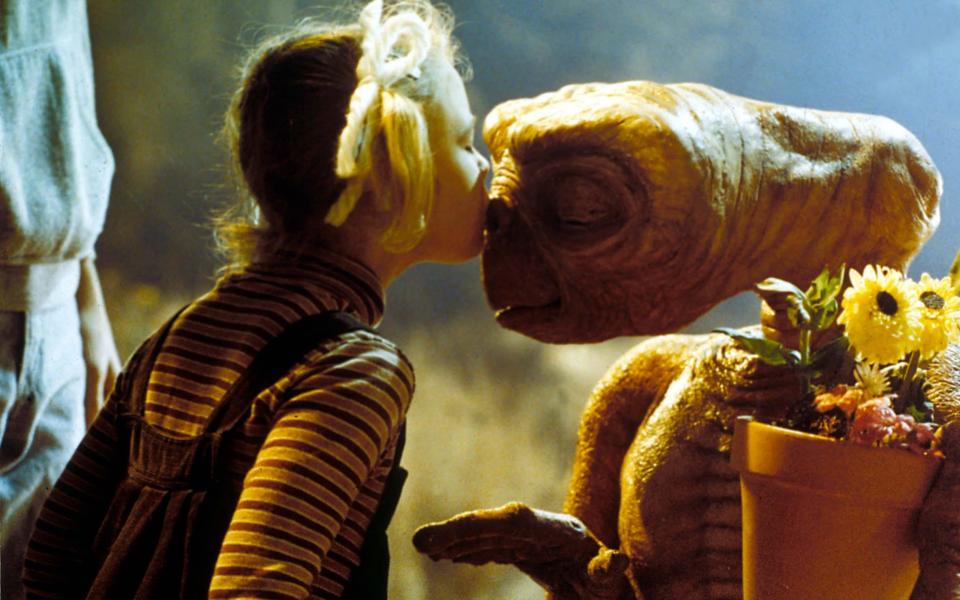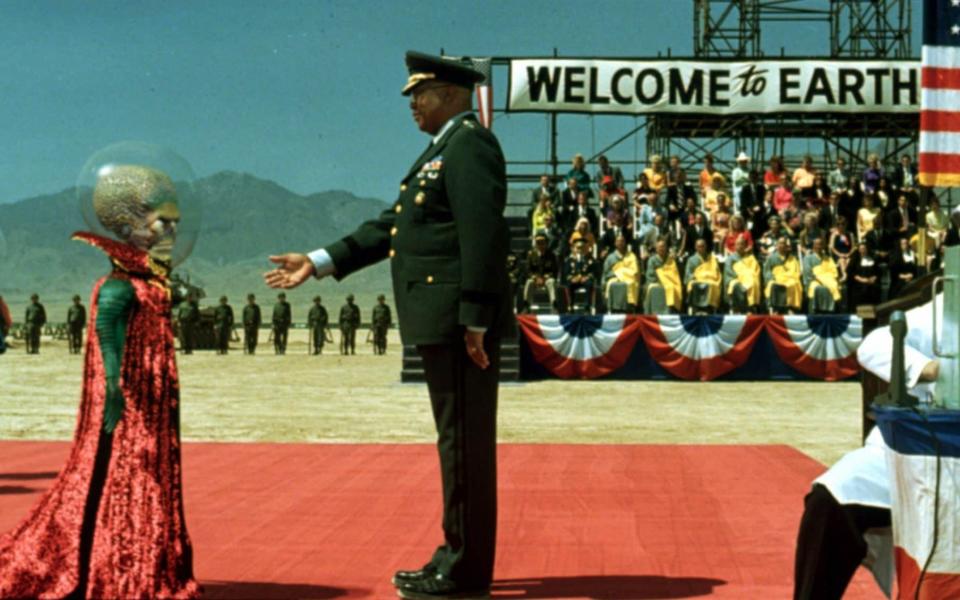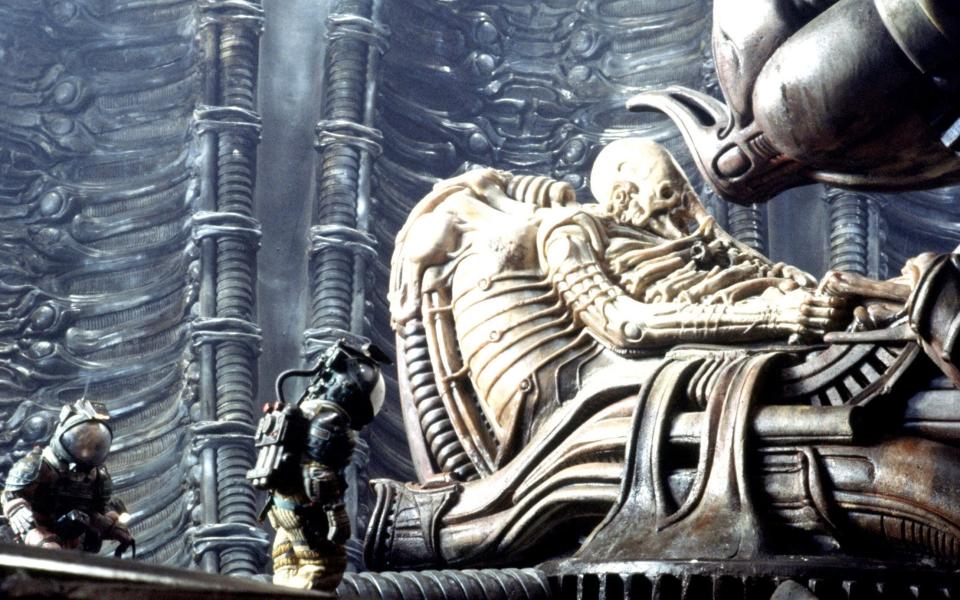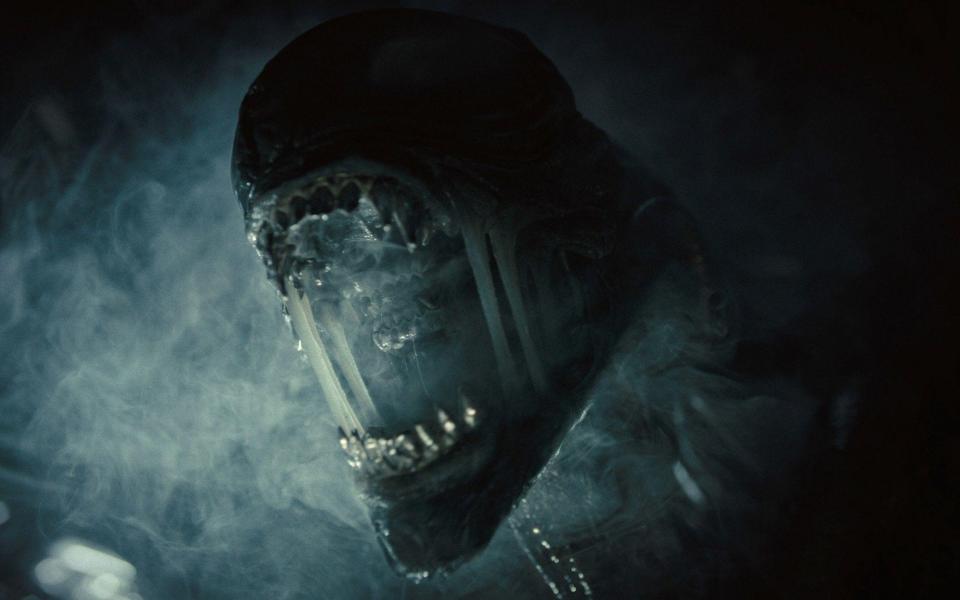This summer, director Fede Alvarez returns the infamous Alien franchise to its monster-movie roots, feeding a group of hapless young space colonists into a nest of “xenomorphs.”
It remains to be seen whether Alien: Romulus will be more than a loving tribute to Ridley Scott’s original 1979 Alien, but it hardly matters—Alien is a series that survives not because of, but in spite of, its canon. Even the worst sequels have failed to bankrupt its bleak message, and even the most visionary reimaginings seem to do nothing to change it.
The original Alien is a dour rehash of John Carpenter’s nihilist-hippie debut, 1974’s Dark Star. It follows an interstellar demolition crew who are unimaginably far from home, dying of boredom, and occasionally terrorized by a mischievous alien beach ball. Dan O’Bannon co-wrote both Dark Star and Alien, and inside every grasping-jawed xenomorph is a cackling O’Bannon-esque balloon creature.
O’Bannon’s cosmic joke goes something like this: We’ve escaped the food chain on Earth, only to find ourselves at the bottom of an even bigger, scarier food chain among the stars. You don’t need an adventure in space to see the lesson. Carpenter made The Thing (1982), in which brilliant and resourceful researchers at an Antarctic base are turned into buddies by an alien’s hunger. You don’t even need an alien. Jaws dropped the good people of Amity Island, NY, back into the food chain, and that was four years before Alien.
Alien was, according to O’Bannon’s famous introductory line, “Like Jaws in space,” but it added a whole new level of existential dread by taking the action beyond our planet. Alien shows us that if nature is red with tooth and claw here on Earth, it’s likely to be so there too. The heavens can’t be heaven at all: here’s an idea calculated to strike fear into fans of 1982’s E.T. the Extra-Terrestrial.
In ET, intelligence is important – the visiting alien is good-natured because he is a space traveler. Any species intelligent enough to travel between stars is intelligent enough not to devour its neighbors. Indeed, the whole point of space travel is botany and horticulture.
Ridley Scott’s later Alien films, Prometheus (2012) and Covenant (2017), offer complex counterarguments to ET, in which cosmic gardeners called the Engineers gleefully spread an invasive species (dust that creates a black xenomorph) across the cosmos.
“But for God’s sake—why?” ET fans shout, their big, trusting kitten eyes watering at all this interstellar mayhem. And they’re right. When you have to compete for limited resources, violence makes evolutionary sense. But once you travel between stars, the resources available to you become infinite. Assuming you can move around freely in space, there’s no point in being hostile.
If the possibility of interstellar life has provided the perfect conditions for many Hollywood blockbusters, hunting for aliens in real life has had more mixed results. When the Exposition Universelle in Paris opened in 1900, it was full of wonders: the world’s largest telescope; a 148ft diameter “Cosmorama” (a restaurant and planetarium); and the announcement of a prize given by socialite Clara Guzman: 100,000 francs (£500,000 in today’s money) to the first person to make contact with an extraterrestrial species.

By 1900, extraterrestrial existence was no longer a strange idea. The habitability of other worlds had been seriously debated for centuries, and proposals for how to communicate with other planets were multiplying: these projects included everything from mirrors to earthworks that could be seen from space.
What is striking is the award’s exclusion clause, written in small print. Communicating with Mars would gain you nothing, because Mars connections had already been established. Radio pioneers Nikola Tesla and Guglielmo Marconi would go on to claim that they had received signals from space. Percival Lowell, a brilliant astronomer working at the cutting edge of optics, claimed to have found giant irrigation systems on the surface of the red planet: in his 1894 book he published clear visual evidence of Martian civilization.
Half a century later, our ideas about aliens had changed. Further examination of Mars and Venus showed them to be lifeless, or close to it. Meanwhile, the universe had turned out to be many times bigger than anyone had thought in 1900. Bigger—but still completely silent.
In the summer of 1950, during a lunch conversation with colleagues Edward Teller, Herbert York, and Emil Konopinski at the Los Alamos National Laboratory in New Mexico, Italian-American physicist Enrico Fermi posed the question: “Where is everybody?”
The galaxy is old enough that other intelligent species capable of interstellar travel have visited every star system many times. Enough time has passed for galactic empires to rise and fall. And yet, when we look up, we find absolutely no evidence of them.


We began our hunt for alien civilizations in the 1960s using radio telescopes. Our perfectly reasonable position was that if We They are here, why not? Them there? The possibilities for life in the universe have blossomed around us. We have found that nearly all stars have planets, and most have rocky planets orbiting the habitable zone around the star. Water is everywhere: there are only a few alien oceans that we know of in our own solar system. Microbes that can withstand the rigors of space have been found on Earth. The impacts of large meteor strikes have undoubtedly flung them into space from time to time. Even now, some of the more resilient species may be thriving in strange corners of Mars.
All of this makes the cosmic silence even more disturbing.
Maybe ET isn’t interested in us. You can see why. Space travel has proven to be much more difficult and unimaginably expensive than we expected. Even our very close neighbors are nearly impossible to visit. Space is big, and it’s hard to see how the travel times to even our closest planets wouldn’t destroy a living crew.
Traveling between star systems is another order of magnitude impossible. Even allowing for the show’s questionable physics, it remains an uncomfortable fact that whenever Star Trek’s USS Enterprise hops between star systems, the energy needed has to come from somewhere. Is the United Federation of Planets breaking up, refining, and extinguishing entire moons?
Life, even intelligent life, may be widespread in the universe – but then each instance must live and die in isolation. The distances between stars are so great that even radio communication is impractical. Civilizations are high-energy phenomena, and all high-energy phenomena are rapidly extinct. By the time we receive a possible signal from an extraterrestrial civilization, that civilization is likely to be long dead.


It’s worse. As the universe ages, it creates different kinds of suns. Suns like ours are an old model and are long gone. Life like ours has had its golden age in the cosmos, and one of the most likely answers to the question “Where’s everyone?” is “You’re too late to the party.”
Others have offered even more disturbing theories for the silence. Cixin Liu is a Chinese science fiction novelist whose Hugo Award-winning The Three-Body Problem (2008) was recently beamed to Netflix. Liu sees the universe as a “dark forest,” in which space-faring species are by definition so technologically advanced that no planet can mount a defense against them. It’s better to keep quiet: there may be wolves out there, and the longer our neighboring star systems remain silent, the more likely it is that wolves are nearby.
Russian rocket pioneer Konstantin Tsiolkovsky, who pondered our silent skies a few decades before Fermi, was more optimistic. Spacefaring civilizations are all around us, he said, gardening the universe (anticipating ET). They will not communicate with us in our fragile, planet-bound state, like Spielberg’s alien stepping on a newly discovered caterpillar.
But this is a vision of alien life that demonstrates an unlikely self-control. The problem with intelligent beings is that they can’t leave things alone.


Late 20th-century Soviet science fiction novelists and brothers Arkady and Boris Strugatsky argued that the sole purpose of life for a space-faring species was to ensure the well-being of the universe by fostering sentience, consciousness, and even happiness.
Puppen, one of the most compelling alien heroes, grumbles: Yes, but what kind of consciousness? What kind of happiness? In his 1985 novel The Waves Extinguish the Wind, alien chaser Toivo Glumov writes, “Nobody believes that the Travelers intend to harm us. That is indeed extremely unlikely. We are afraid of something else! We are afraid that they will come and do us good, as they understand it!” Fear is, first of all, of enemies, of those who think they are doing you good.
In the Strugatskys’ wonderfully paranoid Noon Universe stories, aliens are walking among us, pushing us toward ideas of the good life. Maybe so. Either way, how do we know? From my perspective, alien researchers could be quietly mowing their lawns right now, say in Slough. They live, laugh, and love like humans; they even die like humans. In their spare time, they write elegant short stories about the quirks of the human condition, and it doesn’t even occur to them (thanks to their memory blocks) that they’re delivering vital strategic intelligence to a mothership hidden behind the Moon.
You can belittle my little fantasy all you want; I defy you to disprove it. That’s the problem. Aliens are scientifically indisputable. They are not merely physical phenomena whose abstract existence can be proven or disproved through observation. They are like us: intelligent, elusive, and unpredictable.


The Polish writer Stanislaw Lem had a deeply bleak solution to Fermi’s question, best expressed in his 1986 novel Fiasco. By the time a civilization had reached a point where it could communicate with others, he argued, it was already hopelessly closed in on itself. At best, its individuals would live in simulations; at worst, they would wage pyros, planet-shattering wars against their own shadows. In Fiasco, the crew of the Eurydice discover, too late, that they are as fatally self-obsessed as the aliens they encounter.
We see the world through our own peculiar evolutionary perspective. This gives us a very narrow idea of what life looks like. We competed with our evolutionary cousins long ago, and for all of recorded history, we have been the only species we know of that has anything like our kind of intelligence. Our long solitude may have driven us a little crazy. That’s why we’re not ready to meet aliens – only mirrors. Only angels. Only monsters.
And the xenomorphs of Alien: Romulus are, unfortunately, likely in the same predicament.
Alien: Romulus hits theaters on August 16